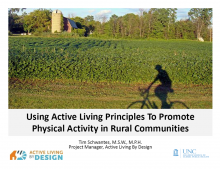We are pleased to announce an exciting new alliance between Active Living Research and GP RED to co-host and coordinate...
Using Active Living Principles to Promote Physical Activity in Rural Communities

Presentation at the 2010 Active Living Research Annual Conference
Background:
Nearly one quarter of the US population live in rural communities. Evidence shows that people living in rural communities are more likely to be physically inactive, overweight and obese compared to those living in urban locations. It is often assumed that rural populations can engage in physical activity more than their urban counterparts because of the expansive amounts of green space and natural environmental amenities, and the thought that many rural occupations are conducive to physical activity. However, rural communities are currently understudied, and there are few well-known strategies for active living in rural settings compared to urban areas. Rural communities are of particular interest to health advocates and researchers as their cultural, social, economic, and geographic characteristics place them at higher risks for many unfavorable health conditions, including obesity resulting from physical inactivity. Opportunities in the physical environment for physical activity, such as access to walking trails, sidewalks, gyms, “walkable” streets, and parks may be limited or non-existent in rural, lower density areas.
Objectives:
Studies of five rural communities - Charleston, SC; Isanti County, MN; Upper Valley, VT/NH; Wilkes-Barre, PA; and Winnebago, NE - that participated in the Active Living by Design (ALbD) program helped to increase understanding in the field about effective policy and community design interventions in those settings. In 2005, the Robert Wood Johnson Foundation (RWFJ) funded 25 ALbD communities for a five year grant period in order to create more opportunities for residents to engage in routine physical activity. Active Living by Design encourages the use of a “5P” community action model that includes strategies for preparation and partnerships, promotion, programs, policy, and physical projects. The 5P strategies were employed by all 25 ALbD partnerships. The experience of the ALbD communities suggests that implementation of the 5P strategies needs to be tailored to maximize effectiveness in more rural communities.
Methods:
Secondary data on the five ALbD rural communities were collected using multiple sources, including web-based program updates by the five partnerships, annual narrative reports submitted to the RWJF by the partnerships, and interview transcripts conducted by the external evaluator for the ALbD program. These qualitative sources provided a holistic viewpoint and spanned the life of the five year grant period. The analyses focused on the following factors in each of the five communities: (1) the culture, (2) implementation of the 5P strategies, (3) assets and challenges experienced, and (4) additional insight that can inform future work.
Results:
People living in rural communities face a variety of obstacles to incorporate physical activity into their daily routines. Some of the barriers are relevant in both urban and rural settings, such as crime and traffic safety, while other barriers are unique or more frequent in rural communities, such as dispersed land use and population which creates greater geographic distances to the nearest town center and other active living opportunities. Many of the resources (i.e. parks, sidewalks, and bike lanes) that encourage physical activity in urban settings are not available, inconvenient, or scarcely available in rural communities. Yet, the five rural ALbD partnerships used innovative strategies to encourage physical activity. For example, successful strategies included events that drew people to town centers, and thereby promoted physical activity and economic opportunities. Utilizing the existing assets, including town or cultural history, as well as physical amenities like lakes or green space also incentivized residents to engage in physical activity.
Conclusions:
Most active living research to date has focused mainly on urban and suburban settings, leaving rural communities with less evidence to guide their community-based physical activity initiatives. Analyses of the ALbD communities suggest that: 1) Planning policies for future development in rural areas need to be especially deliberate about where community resources are located in relation to other amenities. 2) People serve as important resources in rural communities. While human capital is a valued asset in urban settings as well, partnerships in rural areas depend much more on the formal and informal skills, education and expertise of individual leaders and community members, simply because there are fewer people available per geographic area who can fill roles and gaps. In addition, residents in rural communities typically share pride in certain elements of their community, and this sense of pride in community history and culture can be utilized to enhance active living community change efforts. Incorporating these components, developing and maintaining a strong partnership, and thinking creatively can help to promote physical activity in rural communities.
STAY UP TO DATE
RECENTLY ADDED TOOLS & RESOURCES
MOVE! A BLOG ABOUT ACTIVE LIVING
The "Active Living Conference" aims to break down research and practice silos and...







